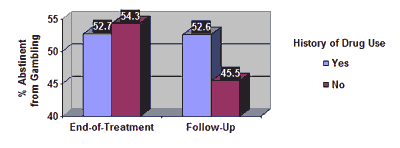The Wager, Volume 8(22) – Does Drug Use Impact Gambling Recovery?
A host of patient characteristics, including engagement in other risky behaviors, can influence the efficacy of pathological gambling treatment. For example, Milton et al. (2002) reported that individuals who used drugs prior to treatment for pathological gambling were about two and a half times more likely to drop out of treatment. In this WAGER, we discuss a study designed to illuminate the effects of lifetime drug use on gambling treatment outcome.
Toneatto et al. (2002) recruited 200 study participants through newspaper advertisements, referral by the gamblers’ significant others, and referral by treatment agencies to receive brief treatment and participate in the research study: 169 patients met the study inclusion criteria (i.e., had at least 5 DSM-IV symptoms; (American Psychiatric Association, 1994) ) and 126 completed the full course of treatment. Participants completed the South Oaks Gambling Screen (Lesieur & Blume, 1987), the Gambling Behavior Questionnaire (Toneatto, 1998), the Readiness to Change Questionnaire (Heather, Gold, & Rollnick, 1991), and additional questions about substance use: at baseline they were asked about lifetime use and use in the last month, and at follow-up they were asked about use in the last year. There were 169 baseline interviews, 126 (74.5%) post-treatment interviews and 79 (46.7%) follow-up interviews.
At baseline, 119 (70%) participants reported using illicit drugs during their lifetime and 24% of lifetime drug users reported their drug use had been a problem at least once. In addition, 27% of participants reported alcohol use had been a problem. The researchers tested the relationship between treatment outcome and drug use but did not test the role of alcohol use. As Figure 1 illustrates, having a history of drug use was not significantly related to gambling abstinence at the end of treatment or at follow-up (c2 p=.46 and p=.51 respectively). Other treatment outcomes (e.g., treatment satisfaction, treatment adherence, SOGS scores and DSM-IV scores) were also independent of lifetime drug use.
Figure 1. Gambling Abstinence for Participants With and Without a History of Illicit Drug Use

The results of this study indicate that a positive history of drug use does not impact on brief gambling treatment outcomes at one-year after treatment. It is important to note, however, that the researchers compared treatment outcomes on the basis of lifetime drug use instead of current drug use at treatment admission. They do not present treatment outcome comparisons as a function of current drug use. This distinction is important: participants currently using psychoactive drugs might fare worse in gambling treatment than participants who are currently abstinent despite having used drugs in the past. Further, this study examined the influence of lifetime drug use, but not past or present drug problems: people who experienced problem use might have different treatment outcomes than people who simply used drugs. Similarly, there is no information provided on concurrent drug treatment: drug treatment might neutralize the effects of pre-treatment drug use on gambling outcome or the extra treatment sessions might even serve to improve both drug and gambling outcomes. Additionally, Toneatto et al. measured only one type of treatment outcome; the results might look different if they examined factors other than abstention. Finally, the low follow-up response rate is problematic and deserves attention. The researchers do not report on the baseline characteristics of participants who were available for follow-up as compared to those who were not available. Therefore, we cannot rule out that those who were unavailable for follow-up were more likely to be the current drug users.
Despite these limitations, The WAGER highlighted this study because it raises important issues surrounding the influence of drug use on gambling treatment outcomes. Although this study suggests that lifetime drug use does not interfere with the brief treatment of gambling disorders, more work is needed to determine the influence of current drug abuse on the positive outcomes of treatment. If drug abuse does exert influence, then treating only gambling addiction in isolation might prove less effective than an approach that is designed to treat co-occurring risk factors and/or addictions simultaneously. Answering these questions requires the gambling field to take a wider view of addiction with respect to interactions between gambling and substance use.
Comments on this article can be addressed to Rachel Kidman.
References
American Psychiatric Association. (1994). DSM-IV: Diagnostic and statistical manual of mental disorders (Fourth ed.). Washington, D.C.: American Psychiatric Association.
Heather, N., Gold, R., & Rollnick, S. (1991). Readiness to Change Questionnaire: User’s Manual. Technical Report 15. Kensington, Australia: National Drug and Alcohol Research Centre, University of New South Wales.
Lesieur, H. R., & Blume, S. B. (1987). The South Oaks gambling screen (SOGS): A new instrument for the identification of pathological gamblers. American Journal of Psychiatry, 144(9), 1184-1188.
Milton, S., Crino, R., Hunt, C., & Prosser, E. (2002). The effect of compliance improving interventions on the cognitive-behavioral treatment of pathological gambling. Journal of Gambling Studies, 18(2), 207229.
Toneatto, T. (1998). The Gambling Behavior Questionnaire. Unpublished manuscript.
Toneatto, T., Skinner, W., & Dragonetti, R. (2002). Patterns of Substance Use in Treatment-Seeking Problem Gamblers: Impact on Treatment Outcomes. Journal of Clinical Psychology, 58(7), 853-859.